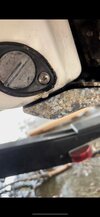Hello - I recently purchased a 2012 Challenger 180 SP with around 120 hours that was in great shape... or so I thought. 24 hours after putting it in the water I came back to about 12 inches of water in the hull. There are no visible issues with the hull itself, what areas should I inspect for leaks otherwise? I've been looking for service manuals to advise but cant seem to find anything helpful. Thanks in advance for the assistance!
-
This site contains eBay affiliate links for which Sea-Doo Forum may be compensated.
2012 SeaDoo Challenger 180 SP Leaking
- Thread starter SamDooSea
- Start date





